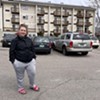Published May 16, 2012 at 11:01 a.m. | Updated November 19, 2020 at 5:10 p.m.
It took Robert Stiller 30 years to build Vermont’s single-serve coffee empire — and just six days to lose it. He spent three decades growing Green Mountain Coffee Roasters from a lone café in Waitsfield into a stunning commercial success, worth $17.1 billion at its peak last September. By 2011, Stiller had amassed a personal fortune worth $1.3 billion, earning him a place on Forbes’ list of the 400 richest Americans.
But two weeks ago, the 68-year-old chairman of the GMCR board experienced a reversal of fortune. When the Waterbury-based coffee company released its second quarter earnings report, the results appeared to confirm Wall Street’s fears: that its once explosive growth was slowing and that management might not be fully in control.
GMCR’s stock plunged. Within 24 hours of a Wednesday evening earnings call, the company lost half its value. On Friday afternoon, Stiller’s bank warned him that because he’d used his Green Mountain shares as collateral for loans and the stock had tanked, he had to come up with more cash — or the bank would liquidate some of his holdings.
The following Monday, Stiller sold his 12 percent stake in Krispy Kreme to raise $51.4 million in cash — but it wasn’t enough. His brokerage firm, Deutsche Bank, forced him to sell five million shares of Green Mountain stock worth $125.5 million, leaving him with just a 5.4 percent stake in the company he built.
Adding insult to injury, the company’s board of directors announced the next day it had stripped Stiller of his board chairmanship, which earned him $175,000 in cash and stock options last year. It described the forced stock sale as “disappointing.” The board said Stiller and another director — former CEO William Davis, who was stripped of a board committee chairmanship — had run afoul of a new company policy to prevent insider trading, which bars employees and board members from selling stock during certain periods. Both remain unpaid members of the board — for now.
“Regardless of the circumstances, the fact that trades were executed when the window was not open was inconsistent with the insider trading policy,” says GMCR spokeswoman Suzanne DuLong, “As a result, the board deemed this was an appropriate action to be taken.”
For Stiller, it was a crushing blow.
“I am really shocked and hurt,” Stiller told CNBC last week. “There were no SEC laws broken, nothing that was in violation of federal law. I’m stunned. I’ve always been transparent with the board. I think it’s an overreaction.”
An early acolyte of Deepak Chopra, Stiller had built a reputation as an enigmatic entrepreneur with a taste for meditation, the philosophy of “appreciative inquiry” and corporate responsibility. But in the days following his ouster, he was pilloried in the financial press for foolishly over-leveraging himself to live high on the hog.
Last year, Stiller bought a $17.5 million Manhattan apartment from New England Patriots quarterback Tom Brady and a $10 million house in Palm Beach, Fla. According to one close friend, Stiller recently sold his 164-foot yacht “Grace E” — with room for 12 guests and 11 crew — in order to upgrade to a larger yacht he has commissioned. And he continued to plow money into the South Burlington-based private jet service he owns, Heritage Flight, which last year billed Green Mountain Coffee $700,000 for travel services, according to Bloomberg News.
Attempts to reach Stiller by email and phone at Heritage, Green Mountain Coffee Roasters, and his homes in Charlotte and Palm Beach were all unsuccessful.
“Maybe I shouldn’t do these things, but I’ve worked all my life building this company and it’s been successful,” Stiller told the Associated Press last week. “I want to enjoy it. Whether it’s living lavishly, I think that’s all relative.”
Stiller’s appetites aside, skeptics have questioned whether the recent volatility represents a hiccup or a bursting bubble for Vermont’s fourth largest employer. Only one other company in Vermont — National Life — generates more revenue, and none other has grown so large, so fast.
Depressants to Stimulants
Legend has it that Stiller, on a 1980 ski trip to Sugarbush, was sipping a cup of coffee in a Waitsfield café when inspiration struck: There was a huge potential market for high-quality coffee, and he was in a position to tap it. So he invested in the café, incorporated it as Green Mountain Coffee Roasters the next year and bought out the original owners.
Dan Cox, who now runs Coffee Enterprises in Burlington, was working at the café at the time: “His vision was, ‘There’s something going on here. This feels like ground zero. I’m willing to risk some resources to bring this to the next level, but I don’t know where that next level is.’”
Stiller had already earned one fortune. In 1971, the 28-year-old Scarsdale, N.Y., native cofounded a company that developed E-Z Wider rolling papers, which were ideally suited for rolling joints — a clear growth market at the time — though Stiller told the Wall Street Journal he wasn’t a “heavy pot smoker.” The product caught fire and, a decade later, he and his partner sold the company for $6.2 million.
According to Cox, Stiller plowed his entire rolling-paper fortune into growing Green Mountain Coffee Roasters, selling a New York City condo and several paintings to finance the fledgling coffee company.
“That’s the thing that bothers me when he’s trashed now. This doesn’t happen overnight,” Cox says. “You don’t realize what they did the first 10 years.”
One by one, Green Mountain built coffee shops around New England, launched a mail-order business and sold coffee beans roasted in a Waterbury plant to wholesale customers. In the late ’90s, the company expanded its organic and then Fair Trade blends, while slowly making inroads to airlines, gas stations and grocery stores. In 1998, Green Mountain jettisoned its retail stores to focus on its far more profitable wholesale operation.
Another key milestone came that year as Green Mountain shipped its first K-Cup, which was compatible with the new single-cup-brewing system developed by Massachusetts-based Keurig. GMCR had invested in the system from the start and, by 2002, had a 40 percent stake in Keurig. Four years later, it bought the company outright.
“Keurig changed the entire company,” Cox says. “They were still a coffee company, but they also became a consumer-appliance company.”
The investment was a resounding success. Last year, K-Cup-related products accounted for 85 percent of the company’s $2.7 billion sales revenue. In 2011, the company sold 5.9 million Keurig brewers and $1.7 billion worth of K-Cups.
Trouble Brewing
For most of its history, Green Mountain Coffee grew slowly and steadily. Then, in 2009, it went on a buying spree, acquiring competitors such as Tully’s, Timothy’s and Van Houtte, and diversifying the coffee brands available in its K-Cups. The company’s stock soared 20 points in March 2011 when it inked a deal with Starbucks to distribute the company’s coffee in K-Cup form. By September, the stock price had quadrupled within a year to a high of $116, valuing the company at $17.1 billion.
But as Green Mountain’s revenues and profits grew, so did its problems. Shareholders filed lawsuit after lawsuit, alleging insider trading by the company’s executives and board members. The U.S. Securities and Exchange Commission launched an inquiry into the company’s revenue-recognition practices, which, according to Doug Newman of Stowe-based Pinnacle Advisors, “pulled the covers off and allowed others to begin examining the company and how it was operating.”
Soon, hedge-fund managers, reporters and bloggers such as convicted felon-turned-whistleblower Sam E. Antar were on the case, snooping around for evidence of accounting irregularities.
One of those who gave the company a closer look was hedge-fund guru David Einhorn of Greenlight Capital, who had previously predicted — and profited from — the demise of Lehman Brothers. On October 17, Einhorn delivered a stunning, 110-slide presentation at a Manhattan investment conference, calling into question nearly every aspect of the company’s growth projections. Green Mountain’s stock dropped more than 13 percent during the presentation — and never recovered.
Einhorn’s allegations? The company, he said, was spending too much, disclosing too little, overestimating the untapped market and engaging in accounting “shenanigans.” He also called fresh attention to the fact that two critical Keurig patents are expiring this September. Competitors would soon produce their own K-Cups, he argued, forcing Green Mountain into a price war that would result in smaller profits and slower growth.
Ian Wyatt of Richmond-based Wyatt Investment Research attended Einhorn’s presentation and immediately shorted the stock — essentially betting that its value would drop. Einhorn too was short-selling the stock.
“I’m a huge fan of Green Mountain as a consumer, but I think [Einhorn] made a pretty good case,” Wyatt said. “More and more concerns are being raised and investors are really doubting how much legitimacy there is in the numbers and how much they can trust the financials that are being reported.”
To Michael Huffman, of Burlington’s Rock Point Advisors, Green Mountain’s problems stem more from perception and poor corporate communication than from fundamental problems with the business. In his eyes, the company gave ammunition to critics two weeks ago during the second-quarter earnings call when it failed to adequately explain how it missed the mark on projected sales.
“The primary reason for the 50 percent drop in share price was not the earnings report, nor even the reduced earnings guidance for the remainder of the year. It was the impression that management is clueless and not in control,” Huffman wrote in a research note. “Management’s fumbling emboldens the conspiracy theorists who believe that management has been deliberately misleading investors.”
Cox, who left GMCR in 1992 after a falling out with Stiller, says the company’s biggest mistake has been its failure to fight back against critics.
“Howard Schultz wouldn’t put up with this crap,” Cox says, referring to the Starbucks chairman and CEO. “They’ve been passive. What they’ve done is, ‘Let’s take the high road. Let’s not respond. We’ll kill them with numbers.’”
To Wyatt, all these problems raise an obvious question: “Is a team good at running a billion-dollar company good at running a $3 billion company?”
A Tempest in a Coffeepot?
“Success often paints a big target on your back,” says Vermont Secretary of Commerce Lawrence Miller. Like many GMCR partisans, he argues that recent market volatility has more to do with Wall Street traders making a quick buck than with the company’s fundamentals, which he believes are strong.
“On the operations side of the business, we really don’t see any reason to have concerns. Obviously, the shortsellers are out and have been trying to make money by posing the company in a bad light,” Miller says. “They’re definitely getting gamed, so there’s a big gap between reality and perception and market price.”
And while growth may have undershot expectations last quarter, the company is still growing by leaps and bounds.
“Let’s be clear: The company did net sales of $885 million — almost a billion dollars in sales — and that’s up 37 percent over last year,” says DuLong, GMCR’s spokeswoman.
DuLong would not directly address Einhorn’s allegations, but she knocked back the notion that Green Mountain’s expiring patents pose an existential problem to the company. She argued that the two expiring patents are part of a “much broader intellectual property portfolio” that continues to expand as the company innovates. It has developed a new “Vue” single-cup system and is working with the Italian-based Lavazza to market a single-serve espresso machine for the North American market. Finally, she argued, the company’s advantages in manufacturing and the diversity of its K-Cup brands have solidified its position in the market.
“I think this company has worked very hard to keep up with its growth, and that’s true both in terms of its manufacturing, infrastructure and capacity, but also in terms of its leadership,” she says.
“People like the Keurig machine, they like the coffee, the research and development, and the new products,” says Sen. Hinda Miller (D-Chittenden), a GMCR board member since 1999. In the wake of Stiller’s ouster, Miller was appointed to chair its governance committee. “The core of delivering value and creating a culture that supports their employees and vendors and stakeholders is sometimes separate from what goes on when you’re part of a stock market.”
Regular or Decaf?
As GMCR has grown from a regional roaster to a Wall Street darling — and then scourge — two contrasting images of the company have emerged. Detractors see a company that has lost its moral compass, improperly enriched its leadership, skirted the law and built a business on expensive, disposable plastic pods that pollute the environment.
Supporters, meanwhile, say the company practices the corporate social responsibility it preaches. It donates 5 percent of pretax profits — $15 million last year — to social and environmental causes, provides generous compensation and benefits to its employees, and pays them to volunteer 52 hours a year. When Tropical Storm Irene struck the company’s hometown of Waterbury, it donated $50,000 to the town and another $250,000 to the American Red Cross.
A similar contrast can be found in Stiller, the man who perhaps built GMCR in his image. Though described by friends as humble, quiet and spiritual, he has been accused over the years of insider trading, incompetence and greed. A gifted entrepreneur who built two wildly successful companies, Stiller made the mistake of holding 90 percent of his fortune in a single stock — and using it as collateral to borrow millions more.
In the days after his ouster, the financial press inventoried the luxury items Stiller has accrued since he stepped down as CEO of the company in 2007: the yachts; the properties in Vermont, New York and Florida; the 10-plane private jet service.
But friends and colleagues say that portrait misses the mark.
“I really don’t see him as being that type of playboy jetsetter,” says friend Nigel Mucklow. “Bob’s a very quiet, gentle man. He is a very deep-thinking man. He’s not a showy man.”
According to Mucklow, Stiller has practiced quiet acts of philanthropy throughout his career, rarely mentioning them to friends and avoiding public recognition.
Champlain College president David Finney says that while Stiller has provided “substantial” financial support to the college — in the seven-figure range — Stiller’s real contribution has been his “advice and wise counsel.” Last summer, Stiller chaired the Champlain College Summit, which brought hundreds of leaders from Vermont’s nonprofit, business and government communities to the Burlington campus to plan the college’s future. Finney incorporated into the program Stiller’s philosophy of “appreciative inquiry”: focusing on what an organization does well, not eliminating what it does badly.
“He strikes me as a very spiritual guy,” Finney says. “He wakes up curious and eager to engage in the world.”
Stiller would be less upset about losing his fortune, according to his friends, than losing control of the company he built.
“It’s hard. I think he feels hurt, a little betrayed, embarrassed. But he’ll get through it,” says Cox, who rekindled his friendship with Stiller years after Cox left the company. “His best intentions and his loyalty to the company are unswerving. It’s never been about the money — never about the money. If it was, he would have cashed out after four years.”
Bill Shearer, who has known Stiller for 30 years, says his friend “has lived with risk before and weathered it.” Like others, Shearer believes Stiller may have another act in him at Green Mountain Coffee Roasters and could emerge again in the company’s leadership.
“I’m not sure that situation’s played out,” Shearer says. “He cares about the company. It’s his life’s work. Bob will prevail.”
Green Mountain Coffee in the Green Mountain State
The people of Waterbury have a different kind of stock in Green Mountain Coffee Roasters. Although the coffee company has expanded its operations to Williston, South Burlington and Essex — as well as seven other states and provinces — it still calls Waterbury home. Since Tropical Storm Irene flooded the state-worker complex, the town has looked to GMCR for economic stability.
“We lost over 1200 [state] workers, but having Coffee Roasters downtown has softened the blow a little bit,” says Rep. Tom Stevens (D-Waterbury). “I think people are nervous about seeing such a steep drop.”
Municipal manager Bill Shepeluk echoes the sentiment.
“I think people in the community are curious as to what’s going to happen. I think people are saying, “Wow, they removed Stiller as chairman of the board. He was the guy who built this company.’”
At the same time, both men are hopeful that Wall Street machinations won’t impact Green Mountain’s commitment to the town — and the state.
“Everything we’ve been hearing is that Coffee Roasters is still growing, still planning on increasing employment in Vermont, including Waterbury,” Shepeluk says. “Has any of this changed those plans? I don’t know that. I can’t say.”
Last October, GMCR announced plans to expand its Essex facility and hire 500 new workers to staff it. The company also said it would build new plants in Virginia and another location yet to be determined.
During the recent earnings call, Green Mountain officials said they now planned to spend no more than $575 million on capital expenditures this year — a figure that includes new facilities — instead of a previously announced $700 million.
But according to DuLong, the company has not scaled back its ambitions in Essex and Virginia and still plans to add 500 workers to its Vermont workforce of 1740 employees. She said the company “may elect to defer” its plans for the additional facility outside Vermont, though it has not made a final decision.
“The expansion that is under way in Essex is the largest manufacturing expansion since IBM was growing in a big way back in the ’90s,” says Greater Burlington Investment Corporation president Frank Cioffi.
According to Secretary Miller, all the focus in Vermont on Green Mountain’s trials and tribulations can be attributed to “growing pains” and “being in the spotlight of a publicly traded company” — one of very few in the state.
Some observers are less confident that Vermont will remain unscathed by a Green Mountain slowdown.
“I think it would be naïve to think that this is just a Wall Street thing and isn’t going to have ramifications on the local economy,” says Wyatt, the Richmond-based analyst.
While Stiller and Davis remain unpaid members of the board for now, the two Vermonters could be pushed out entirely and replaced with directors less connected to the state. Michael Mardy, who was appointed interim chairman following Stiller’s ouster, is the chief financial officer of New Jersey-based Tumi Luggage.
For his part, Cox believes the real threat posed by Green Mountain’s stock meltdown is the possibility that another company might “swoop in and buy it.” The situation is reminiscent of another Waterbury-based company — this one specializing in ice cream — that went public and was bought by an international conglomerate.
“I think it’s an attractive takeover target, and that scares people,” Cox says. “When you go public, all bets are off.”
Timeline
1979: Husband and wife team Doug and Jamie Balne open Green Mountain Coffee Roasters, a small café in Waitsfield. Locally roasted coffee is already popular on the West Coast, but this Mad River Valley shop is the first of its kind in New England.
1980: Company lore has it that Bob Stiller, after skiing at Sugarbush, swings into the Waitsfield coffee shop for a quick cup of joe. Impressed by the coffee, he invests in the café — later buying out the Balnes and another partner. GMCR incorporates in 1981.
1993: After growing slowly for years, and launching a popular mail-order business, Stiller takes the company public.
1997: In one of the company’s first big breakthroughs, GMCR strikes a deal with Mobil — later to become ExxonMobil — to have its coffee served in New England gas stations.
1998: GMCR shutters its last remaining retail location to focus on wholesale business. In the same year, the company buys into Keurig, a Massachusetts-based company that developed a single-serve coffee machine using the patented K-Cup method of brewing.
2006: GMCR buys Keurig outright. Sales of the single-serve machines tally 242,000. Just three years later, that figure will jump to 2.3 million.
May 2007: After 26 years at the head of the company, Stiller vacates his position as GMCR’s president and chief executive but remains chairman of its board.
2011: Share prices rocket from $34 a share at the beginning of the year to $116 by mid-September, when shares trade at more than 65 times the company’s estimated earnings. Then, in October, stock prices dive — after hedge fund manager David Einhorn gives an extensive, 110-slide presentation to investors in New York, detailing his concerns about the company. He cites the impending expiration of its K-Cup patents and rumors of suspect accounting.
February 2012: Stiller sells one million shares of GMCR stock valued at $66.3 million — shortly before the price plunges on news that Starbucks has developed a rival for Keurig’s popular K-Cup machine.
May 2012: After news that GMCR’s projected quarterly earnings have fallen far short of expectations, share prices sink to $25.87, shedding nearly half their value. Days later, Stiller’s bank sells GMCR stocks worth $125.5 million — held in a margin account — after their value drops too low to secure an outstanding loan. The GMCR board ousts Stiller as board chairman, on grounds the involuntary stock sale violated internal trading policies.
More By This Author
Comments
Comments are closed.
From 2014-2020, Seven Days allowed readers to comment on all stories posted on our website. While we've appreciated the suggestions and insights, right now Seven Days is prioritizing our core mission — producing high-quality, responsible local journalism — over moderating online debates between readers.
To criticize, correct or praise our reporting, please send us a letter to the editor or send us a tip. We’ll check it out and report the results.
Online comments may return when we have better tech tools for managing them. Thanks for reading.
















































